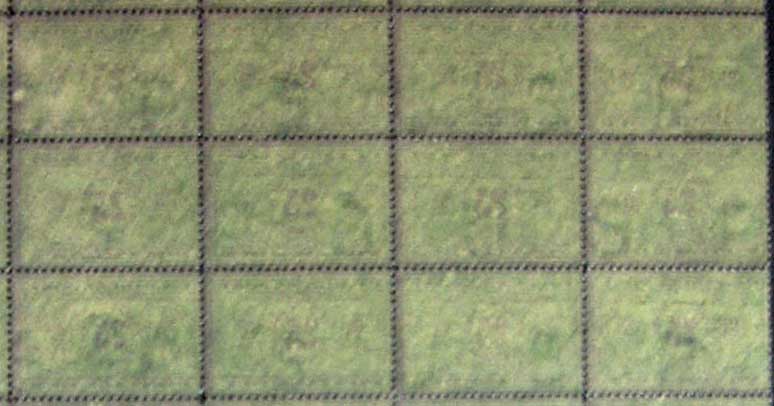Single-line USPS Watermarks
on United States Postage Stamps
By Bob Allen
The "single-line" USPS watermark, introduced in 1910, was one of many experiments the Bureau of Engraving and Printing made to reduce waste due to paper shrinkage. This experiment lasted until 1916 when unwatermarked paper was reintroduced. United States has not used watermarked paper on its postage stamps since, other than the error stamp Scott 519 and the $1 Prexie error stamp, Scott 832b.
The un-retouched photo shown provides an excellent example of the possibilities of single-line watermark position. The stamps are part of a used sheet of the 25c Parcel Post Postage Due of 1912. Although the regular issues, that is the Washington Franklin stamps, are smaller than the stamps illustrated here, the underlying principles are the same. The watermarks form a staggered pattern of the letters "USPS", with every other row identical. The letters form diagonals. Contrast this with the double-line "USPS" in which the letters read "USPS" in both perfect horizontal and vertical rows and columns.

For the following the above stamps have been numbered one to twelve reading from left to right, top to bottom. Stamp one has two easily discernible watermarks, an "S" and a "P". Stamp two has an "S" dead center and part of a "U" at the very right, barely visible in the scan, pointing out out one of the major difficulties in finding a single-line watermark, often a letter that must be there may not be visible at all.
To confirm the placement and necessary existence of the letter "U" in the third stamp, look at stamp eleven, also in the third column. The right half of the "U" is clearly visible at left and is in the exact horizontal position of the "U" in stamp three. Knowing this and comparing with the "U" in stamp eleven, the outline of the right half of the "U" in stamp three, although very weak, can be made out.
The next stamp of interest is stamp eight. It clearly has an "S" at left and a "P" at right, but it also seems to have a partial "U" in the center. This points out the other great difficulty in determining whether a watermark exists, often a non-existent letter seems to be present. As it turns out, part of this non-existent "U" is a cancellation on the front of the stamp and the upper left extension is a legacy of the design of the stamp; note that this mark exists on all of the other stamps. Often, viewing other stamps of the same issue side-by-side with the stamp in question will help you avoid the pitfall of "seeing" a watermark where none exists, by revealing dark areas of the design which will be consistent from stamp to stamp. In addition, keep an eye out for creases, thins and cancellations, which will add dark areas that should not be confused with the watermark.
From this example it is easy to see that identifying single-line watermarks on U.S. postage stamps, is one of the more difficult identifications. Even the experts disagree on the presence of a watermark on many stamps. To compound the problem, the single-line watermark is even more difficult to see on some of the lighter colored stamps. Orange and olive-green stamps present particularly difficult problems. The use of a colored filter of a complementary color may help a little. For example, using a blue filter, the complementary color of orange, may make the watermark on orange stamps more visible.
The single-line watermark was used on U.S. postage stamps from 1910-1916.
The Pan Pacific Exposition commemoratives - Scott 397-404
The Washington Franklins - Scott 374-421, 424-459 and 461
The following Special Delivery stamps - only
Three Official stamps
The Parcel Post stamps
It is interesting to note that no airmail stamps have watermarks since they were not printed until 1918.





